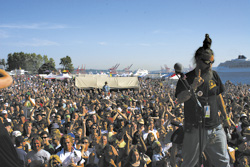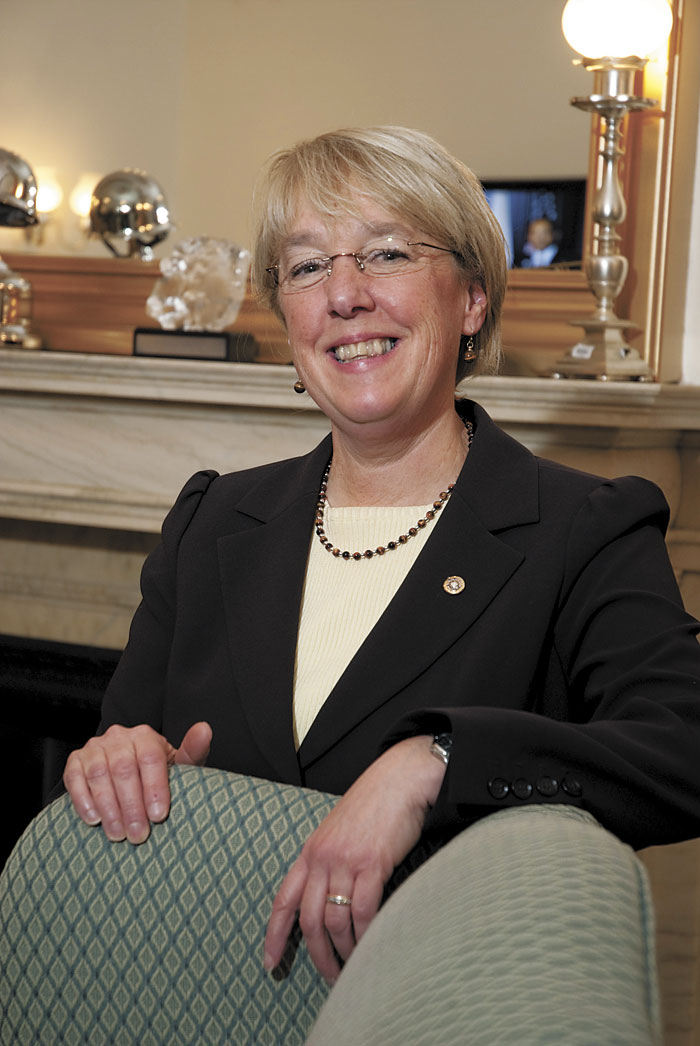Last summer, as the crowd swelled to more than 100,000 on the first day of Hempfest, the annual gathering of ganja enthusiasts at Seattle’s Myrtle Edwards Park, festival organizers worried that the human sea pushing its way in and out of the narrow waterfront venue was becoming dangerously crammed. They say they cut the wire holding up a temporary fence and instructed the crowds to fold the panels over in order to avoid a crush. (The fence was in place to protect waterfront improvements underway as part of the then-unfinished Olympic Sculpture Park, which rises behind Myrtle Edwards and Elliott Bay.)
Early the next morning, in preparation for the festival’s final day, they decided to move the fence farther out of the way, which required displacing some obstacles—namely five giant boulders and two logs that were on the park’s newly regraded beach. They did the unauthorized landscaping with a miniature bulldozer called a Toolcat.
The beach, which was built to enhance public access to the water, was also created to provide habitat for juvenile salmon migrating from the Green and Duwamish rivers. Though no fish were harmed during Hempfest’s lifesaving measures last summer, SAM officials say damage from the event—and the Toolcat—meant they had to start over and rebuild the riparian ecosystem.
The city was similarly nonplussed by the damages, and sent Hempfest a bill for $16,500. Hempfest organizers came back with an offer to pay for half—and a request for a permit to hold their 2007 festival, planned for Aug. 18–19 at Myrtle Edwards Park. “Our position is that it will happen and it will happen in that park,” says Hempfest construction director John Davis. “If it doesn’t happen there, the festival won’t happen.”
Davis says there simply aren’t any other places that will accommodate the event. The festival, which started in Volunteer Park in 1991, outgrew Gas Works Park a few years later. Davis says urban parks like Magnuson are tough to come by because of parking, access, and neighborhood issues; and that larger, more elaborate venues like Seattle Center are simply too expensive. “Plus, at this point of the year, the advertising is already out,” he says. “You can’t just go back and change everything.”
“In the front of everyone’s minds is the issue of capacity,” says Chris Rogers, SAM’s director of capital projects and governmental affairs. “The big issue is public safety. It’s a bad site for so many people. It’s worth looking closely at. I think SAM would hope the city and others could be proactive in determining appropriate locations for appropriate crowds.”
But Davis says SAM is just using the whole overcrowding thing as an excuse.
“Although they won’t say this in any public forum, when it’s just [SAM representatives] and us, they say, ‘Look, we don’t want you there, and we’ll do anything to keep you out,'” he says, adding that this has been SAM’s message since their first meeting, well before last year’s event and the subsequent completion of the sculpture park.
(Last July, Hempfest sued the city and SAM for waiting until the eleventh hour to issue a permit for the 2006 event. Festival organizers withdrew the lawsuit after the city granted the permit in early August.)
No remnants remain today of the damage from last year’s event, though on a recent walk through the park, SAM spokesperson Cara Egan points out the logs that had to be replaced. She says they were there to help nurture the sensitive habitat surrounding them and that there will likely still be fencing up this summer to protect the delicate young plants that line beach and walkway.
Last week, the city attorney’s office met with SAM officials to discuss what protective measures could be put in place to ensure public and private investment in the sculpture park could be protected if the event returns to Myrtle Edwards.
In addition to whether Hempfest will get a permit for this year’s event, the other issue is whether the festival would be allowed to use the gravel ramp and staircase that connects the waterfront park with the sculpture park. The city owns the right of way there, but leases it to SAM. Hempfest’s organizers say use of this piece is critical to ensure enough space for the crowds to get in and out.
The bent fence and memories of the mini-bulldozer on the beach have not helped Hempfest’s cause. Rogers, who headed up the sculpture park project for SAM, says a lot of people contributed to both the park and to the shoreline restoration. “We want to make sure that’s safely protected,” he says. “Assurances to provide those protections last year weren’t met. That’s why we’re dealing with the damage issue.”
But Davis counters that the damages were not Hempfest’s fault. He says they’d warned the city beforehand that the placement of the fence and narrow ingress and egress was a risk to public safety. “The action that we took saved lives and saved the city and SAM millions of dollars in litigation,” he says.
The city ordinance that created the sculpture park stipulates that the waterfront area below shall be available for special events and even names Hempfest as an example. The law also requires festival organizers to protect sensitive vegetation, artwork, and other improvements to the area. In addition, SAM has the right to close the park five days a year, but they must give advance notice.
Seattle City Council President Nick Licata says that the city gave money to the sculpture park and the “quid pro quo” is that the public still gets to use Myrtle Edwards for events. Thought it’s a pretty clear agreement, he notes that it’s still open to some level of interpretation: “SAM says the city gave the museum money so the sculpture garden can be enjoyed by everyone. They say Hempfest stops it from being enjoyed by everyone and damages the park so people can’t enjoy it.”
Licata says it’s unclear whether the damage done to the park last year was done for safety purposes. But it’s also unclear whether the shoreline was really hurt, says Licata. “SAM’s concern is that the logs may have been damaged, but they also say these logs came in during a storm, so they were drift logs. If so, they got there free.”
Whether or not the damage was costly, what’s clear, says Licata, is that if someone would’ve been trampled at Hempfest because of the crowds, “we all would’ve been basically hanging from the same limb.”
Maybe the answer is to simply have a smaller event, Licata says. Council member Jan Drago adds that it’s possible Hempfest has simply outgrown Myrtle Edwards.
Hogwash, says the festival’s executive director, Vivian McPeak. He says the problem is not that the festival is too large; it’s that the entry and exit into the park is too small now that the sculpture park’s there. “We weren’t too large in 2005, and we weren’t too large the day after the obstructions were removed,” he says. “We’ve been in that park for over 10 years.”
McPeak says the key will be getting access to the gravel ramp and staircase—or the “high road,” as Hempfest planners call it.
The museum hasn’t taken a position on use of the high road for festivals, says SAM’s Rogers. But he notes that the sculpture park was never intended as a special-events venue and that the staircase is steep and raises concerns of public safety and liability.
“More than 300,000 people have come to the sculpture park during its first three months alone—and we haven’t even gotten to the good weather,” Rogers says. “We know it’s going to be popular. We want to make sure it’s cared for and used for what it was designed for.”
Sharon Citti, a Kirkland resident who’s lived in the area since 1993 and attended Hempfest a couple of times, says the city shouldn’t have to lose out on another signature event because of the sculpture park. She’s still steaming from the cancellation of the Myrtle Edwards portion of Fourth of Jul-Ivar’s. Ivar’s still sponsored fireworks over Elliott Bay last year, but canned the daylong food and music fest that accompanied it due to growing costs and logistical difficulties (including the loss of parking and staging space because of the sculpture park).
“Fourth of Jul-Ivar’s was a treasure to me. Now it’s gone,” Citti says. “Here’s another cultural icon being threatened. It’s like the Hammering Man of the Seattle Art Museum is hammering on Seattle, saying, ‘We’re going to do it this way.’ I just don’t get it.”
Both the city’s parks and fire departments will weigh in before a decision on permitting is made by the city. Council member David Della says the city’s Special Events Committee is currently considering Hempfest’s application. He says the festival would have to be coordinated in a way that doesn’t disrupt the operations and amenities of both the sculpture and waterfront areas. “That was certainly the case when this happened last year,” Della says. “And it’s definitely the case now that the sculpture park is done.”
“This isn’t a question of good and bad people,” adds Licata. “There are good people on both sides. Their immediate interests are in conflict. This is a classic case of, ‘Can you find a path that can work for all of them?'”
McPeak says Hempfest and the sculpture park should be able to coexist—and that the city’s decision will set a precedent for the other events that follow.
“All along it hasn’t just been about Hempfest. We feel we represent large political special events,” he says. “We think it’s vital to have large open spaces on public property that have been put aside particularly for our right to have free speech.”






